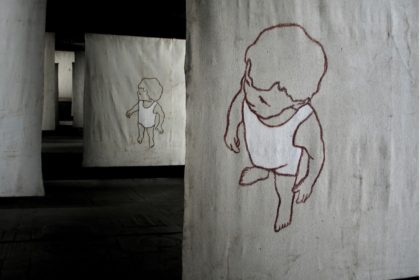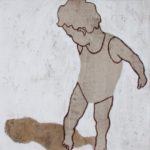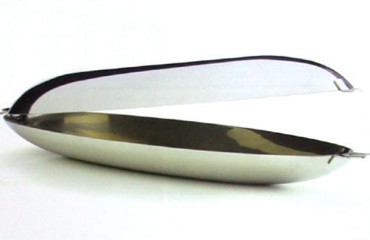
They’re just kids, “just kids”. Only? What does it mean that “only” when it comes to children? We know, we who we are no longer that, explore their light thoughts, we remember the time when we discovered our shadow? Valerio Berruti is an artist who has long dealt with childhood: in his works always appear children, in fact, little creatures that still preserve intact the power of the game, who still have the wonder of discovery.
In his latest project recently concluded – two exhibitions in Milan and Verona, at the respective locations of MARCOROSSIartecontemporanea gallery, and a large installation in front of the cathedral of the Scaliger city – Valerio let his children carry out an inevitable rite of passage: “You become aware, step by step, of your own body, which generates a shadow and that is a kind of blind spot mirror, a black sun. And in an instant paradise is lost”, writes the curator Marco Enrico Giacomelli. But this loss, that if we were to suffer it as “adult” would result in a painful and incurable trauma, in the works making up Paradise Lost this loss is lived with innocence and carefree, like a real game – the plump little hands stretch toward the elusive shadow – with this that from now on it will be the other himself and from which we can no longer separate (unless we are the protagonist – forced to hand over to others his shadow, that slowly dies – of this extraordinary story in Hard-Boiled Wonderland and the End of the World by Murakami Haruki, or again, unless you are Peter Pan).
As his custom, Berruti has found, for this exhibition, collaboration with a musician. To give the sound of animated video created for the occasion is Joan As Police Woman, but in the past the artist has managed to engage intensively in suggestive projects also – to give just two prominent examples – Paolo Conte (for The Daughter Of Isaac, exhibited at the Italian Pavilion at the 53rd Venice Biennale in 2009) and Ryuichi Sakamoto (for his solo exhibit Kizuna in Tokyo in 2011).
Contaminations do not end here. Children, outlined with simple lines and often monochromatic brush strokes that seem almost to recreate their pure inner rooms, are also sensitive issue of publishing projects, in particular the one just published by Gallucci publisher. The Wind in the Willows is born from the “discovery”, in London, of an old edition of the classic for childhood literature written by Kenneth Grahame in 1908. Valerio Berrutti of those pages has drawn 71 figures and now the tables – quickly browsed because for puppies books are, and must be, first of all games – have become a flipbook that in addition to the drawings, encloses the translation made by Cesare Pavese of Grahame’s novel and the verses of the New by Gianmaria Testa, songwriter and Berruti‘s friend who died recently. And the gesture that makes the drawings come to life is perhaps among the few who, in a flash, brings all of us, jaded, cynical, stressed adults, to really relive, for a few seconds, the enchantment of childhood.
Cover: Valerio Berruti, Vocazion, San Agostino’s Church, Pietrasanta, 2004
 English
English  Italiano
Italiano 





